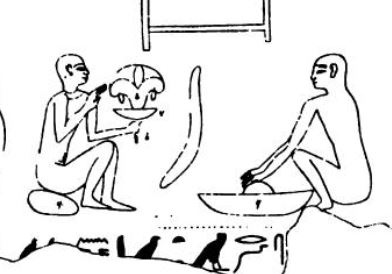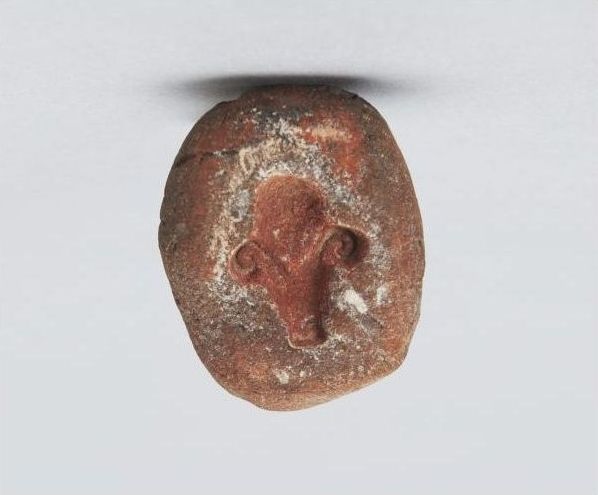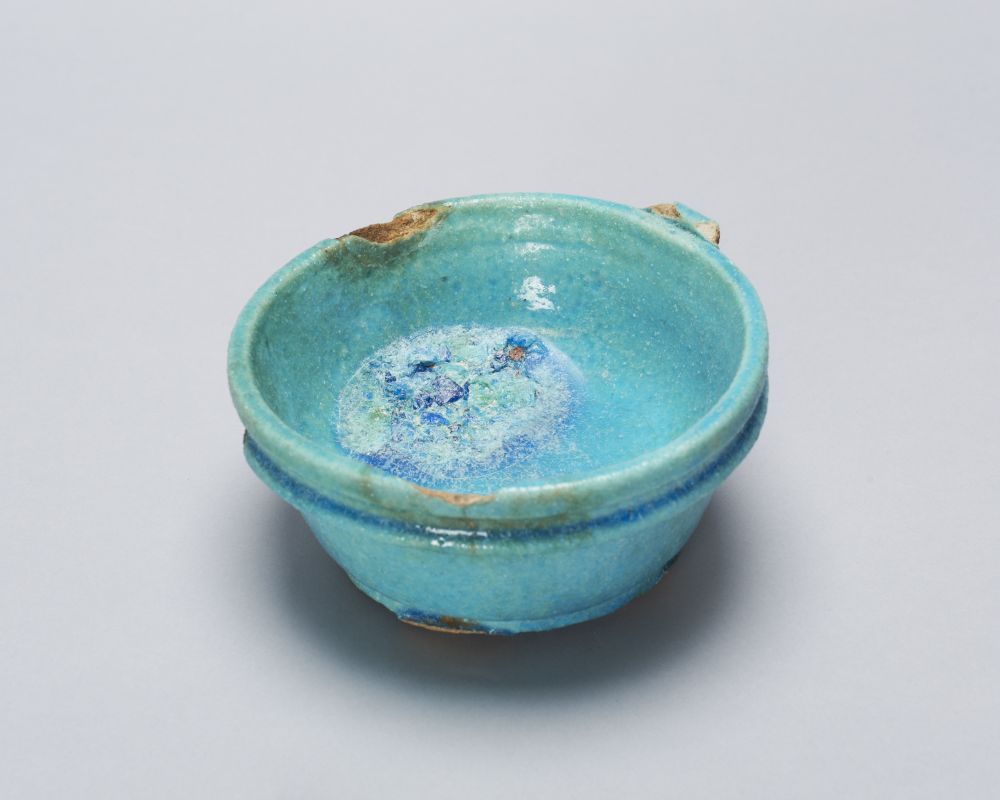Tjehenet
The Brilliant Manufacture of Egyptian Faience
Stephanie L Boonstra
The shiny, blue-turquoise of Egyptian faience was used to make a wide variety of objects in ancient Egypt. In fact, over 250 objects from the Eton Myers Collection at the University of Birmingham were made of faience. While objects ranging from elaborate figurines to crude beads were often crafted of faience, the manufacturing method was lost for millennia. Scientific discoveries in the last twenty-five years have shed some light on how this synthetic material was created.
Dazzling Objects
The ancient Egyptians used the world tjehenet, which means ‘gleaming’, ‘dazzling’, or ‘brilliant’, to describe the material we know call Egyptian faience. Faience is a synthetic material used to create amulets, figurines, bowls, beads, and many more objects. While faience could be a variety of different colours, it was mostly commonly a vibrant, vivid blue to mimic turquoise, a colour that signified life and fertility for the ancient Egyptians. The first documented use of the glazed material was in the Predynastic Period with some simple faience bead necklaces found in tombs at Badari and Naqada.[1]
Over 250 objects of Egyptian faience can be found in the Eton Myers Collection on loan at the University of Birmingham.
How Was It Made?
While faience was used widely in pharaonic Egypt, the ancient Egyptians were not forthcoming with the production methods of this very popular material. Fortunately, scientific studies have been able to dissect the raw materials and production methods necessary for manufacturing these objects. The primary required material for manufacturing faience (as with glass production) is silica. This silica could either come from pure silica sand or from crushed quartz pebbles. A small percentage of faience was comprised of lime and an even smaller proportion of alkali. The lime was simply from limestone, whereas the alkali could come from either natron, from the Wadi Natrun west of the Nile Delta, or from the ash of specific types of Nile dwelling plants. A final, and crucial ingredient in the production of faience is a colourant. The most common colourant used was copper, which created a vibrant turquoise blue seen on objects ranging from amulets to large scepters. [2]
|
|
After mixing these ingredients, the produced paste would then be hand shaped, pressed into a mould, or even thrown on a wheel to create the desired object before it was placed in a kiln. The kiln would need to reach temperatures of 800 to 1000 C in order to harden the object and create a glassy, coloured surface on the artefact.
|
|
Faience Workshops – A look at ECM 586
A number of archaeological excavations in the past 125 years have revealed evidence for the production of faience in ancient Egypt. Evidence for the production of faience at a site includes misfired objects, ceramic moulds, the presence of raw materials (such as quartz pebbles), and kilns. Faience production sites have been found throughout Egypt at Abydos, Lisht, Memphis, Amarna, Naukratis, and more. [3]
|
|
A Roman period faience bowl, ECM 586, that was collected by Major William Joseph Myers in the late 1890s can shed some light on the ancient Egyptian faience industry. Unlike many of the exquisite faience bowls and chalices in the Eton Myers collection, for example, see ECM 811, ECM 586 and a few other Roman faience bowls in the collection display manufacturer errors. The most glaring error is a large mass of multi-tonal cracked glaze pooled inside the bowl. What likely caused this flaw would have been an accident in the kiln where the kiln supports had faulted causing this bowl, and perhaps others, to fire on an angle. As this bowl was glazed by direct application, the glaze slurry then pooled on one side of the bowl and cracked under the intense heat of the kiln. It has been hypothesised that this bowl and other Roman period faience ‘wasters’ in the collection came from a looted faience workshops at the ancient Egyptian city of Memphis; a site that was plundered during the same period that Major Myers collected these vessels and other faience artefacts. [4]
|
|
While this bowl is certainly evidence of a manufacturing error (‘waster’) and was likely rejected, it can shed light on the production of the elusive Egyptian faience. By finding the odd mistakes in the production of ancient Egyptian goods, which are often renowned for their beauty and precision, the workshops of ancient Egypt are brought to life a little more.
[expand title=”Endnotes”]
[1] See Digital Egypt, UCL for examples of faience from the Petrie Museum of Egyptian Archaeology produced during different periods of ancient Egyptian history: http://www.ucl.ac.uk/museums-static/digitalegypt/faience/periods.html.
[2] For a very unique faience artefact, see the over two metre long w3s-sceptre found by Flinders Petrie at an Eighteenth Dynasty temple to the god Seth in the Naqada region, http://collections.vam.ac.uk/item/O131268/sceptre/.
[3] Nicholson (2007) extensively studied the faience industry at Akhenaten’s capital of Amarna in the 1990s and early 2000s to properly re-excavate and document a glazing industry centred around house O45.1.
[4] Nicholson (2013, 7-8) discussed the fact that the faience workshop at Memphis first identified by Flinders Petrie in the late 1880s was then looted before he was able to return to excavate it in the early 1900s. His identification of it as an area of faience industry may have led to is subsequent plundering.
[/expand]
[expand title=”Bibliography and Further Reading”]
Davies, N.d.G. 1902. The Rock Tombs of Deir El Gebrawi. Part I, Tomb of Aba and Smaller Tombs of the Southern Group. London.
DIGITAL EGYPT, 2000. ‘Egyptian Faience and Glazed Ware’, Digital Egypt, University College London. http://www.ucl.ac.uk/museums-static/digitalegypt/faience/index.html
Friedman, F.D. (ed.) 1998. Gifts of the Nile: Ancient Egyptian Faience. London and New York.
Nicholson, P.T. 2007. Brilliant Things for Akhenaten: The Production of Glass, Vitreous Materials and Pottery at Amarna Site O45.1. London.
Nicholson, P.T. 2013. Working in Memphis: The Production of Faience at Roman Period Kom Helul. London.
Nicholson, P.T. and Shaw, I. 2000. Ancient Egyptian Materials and Technology. Cambridge.
Shortland, A.J., 2000. Vitreous Materials at Amarna: The Production of Glass and Faience in 18th Dynasty Egypt. Oxford.
[/expand]




